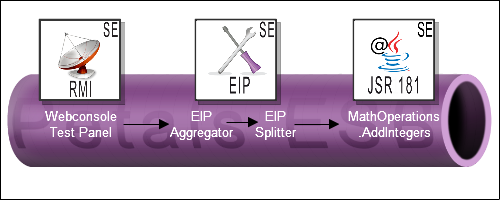Hi ! Today is you last day. You will create a simple process: bufferize messages, and execute all of them in one time with MathOperations. You will use EIP chains for this.
- Petals Guide Package 1.0 - Download binaries here
- Tomcat 6.0.29
- JDK 6 update 20
- SoapUI 3.6
This Tutorial uses:
- Petals Studio
- Petals ESB
- Petals SE RMI
- Petals BC SOAP
- Petals Web console
- Tomcat
- soapUI
- Petals SE Jsr-181
- Petals SE EIP (new)
| This tutorial is based on the use case: Bufferize operations with EIP. |
Integration process definition
You will use Enterprise Integration Patterns (EIP, see below for explanations) to create this process :
- Several messages are sent to an EIPAggregator pattern, which bufferize all incoming messages.
- Trigger message is sent to EipAggregator.
- EipAggregator sends an aggregated message to EipSPlitter.
- EipSplitter splits the aggregated message back into multiple messages.
- EipSPlitter sends the multiple messages to the operation AddIntegers on the service MathOperations.
- MathOperations.AddIntegers processes the messages and send you the responses.
|
What is EIP ?
A set of design patterns for enterprise application integration.
What is Agregator pattern ?
[TODO]
What is Splitter Pattern ?
[TODO]
Configure the Splitter
- Launch Petals Studio.
- Click File > New > Service-Unit Project.
- Select Use a Petals technical Service > EIP > Your_EIP_Version.
- Configure Splitter Service-Unit with following configuration:
Parameter name
Value
JBI properties Note: EIP does not need a WSDL
Interface namespace: http://test.petalslink.com InterfaceName: EipSplitterInterface Service Namespace: http://test.petalslink.com Service Name: EipSplitter End-point Name: EipSplitterEndpoint Project Name and Location Project Name: su-EIP-EipSplitter-provide Chain calls (1) Eip: Splitter Chain calls (2)
Selected Pattern: splitter see below for configuration - Click Add > Edit. It displays the window "EIP: Invoked Service 1".
- Click Select a service.
- Double click MathOperations implements MathOperations @ MathOperationsPort.
- Fill the following properties for Invoked Service 1:
Service Identifiers Note: auto-configured Invocation Properties Operation Namespace: http://test.petalslink.com Operation: AddIntegers Mep: InOut Routing Condition XPath Condition //*[local-name()="AddIntegers"] - Click Ok > Next > Finish.
Configure the Aggregator
- Create a New Service-Unit Project for EIP Technical Service with the following configuration:
| Parameter name |
Value |
|---|---|
| JBI propertie | |
| Interface namespace | http://test.petalslink.com |
| InterfaceName | EipAggregatorInterface |
| Service Namespace | http://test.petalslink.com |
| Service Name | EipAggregator |
| End-point Name | EipAggregatorEndpoint |
| Project Name and Location | |
| Project Name | su-EIP-EipAggregator-provide |
| Specific Component properties | |
| Eip | Aggregator |
| Aggregator Correlation |
boolean(/*[local-name()="AddIntegers"]) |
| Service Parameters | |
| Service Parameters | Select "su-EIP-EipSPlitter-provide" |
| XPath Condition | |
| XPath Condition | boolean(/*[local-name()="AddIntegers"\]/*[local-name()="equals"]) |
| Additional Parameters | |
| Operation Namespace | http://test.petalslink.com |
| Operation | AddIntegers |
| Mep | InOut |
| CDK properties | |
| Validate WSDL | false |
Create and deploy an EIP Service Assembly
There is a tight-coupling between both EIP. Assembling them in one single Service Assembly (SA) can be a good idea (especially with EIP, which can chain lots of patterns, each requiring a different SU).
- Click File > New > Service Assembly Project.
Service Assembly Name: sa-Eip-AggregatorSplitter Artifact ID:
sa-Eip-AggregatorSplitter - Click Next.
- Check su-EIP-EipSplitter-provide and su-EIP-EipAggregator-provide.
- Click Finish.
- Fast-export the Service Assembly for Petals.
- Deploy Petals-SE-EIP in Petals ESB
- Deploy sa-Eip-AggregatorSplitter in Petals ESB.
Understand XPath expressions
What is XPath ?
Run this tutorial (takes ~30 min) for Xpath : http://www.w3schools.com/XPath/default.asp
Now try to understand the XPath expressions we used. If you use EIP later, it is essential to understand and be able to write XPath.
EIP Agregator conditions
- Elements which satisfy "aggregator-correlation" are aggregated
<eip:aggregator-correlation>boolean(/*[local-name()="AddIntegers"])</eip:aggregator-correlation>
Elements inside <AddIntegers> will be aggregated.
- When "test" is true, aggregated message is sent.
<eip:test>boolean(/*[local-name()="AddIntegers"]/*[local-name()="equals"])</eip:test>
When <AddIntegers> contains the <equals> element, the aggregated message is sent to the next service, and buffer cleared.
EIP Splitter conditions
- Elements which satisfy "test" are extracted and sent to the next service.
<eip:test>//*[local-name()="AddIntegers"]</eip:test>
<AddIntegers> elements are split and sent one by one.
Test the EIP chain
- Deploy the SA containing the SU su-jsr181-MathOperations-provide.
- Deploy the SA sa-Eip-AggregatorSplitter.
- Send messages from webconsole, with InOut MEP (message exchange pattern).
- Send the trigger message.
<AddIntegers xmlns:xsi="http://www.w3.org/2001/XMLSchema-instance" > <integer1>1</integer1> <integer2>2</integer2> </AddIntegers>
<result xmlns="http://petals.ow2.org/petals-se-eip/aggregator">Aggregator: the content is buffered by the pattern</result>
<AddIntegers xmlns:xsi="http://www.w3.org/2001/XMLSchema-instance" >
<integer1>3</integer1>
<integer2>4</integer2>
</AddIntegers>
<AddIntegers xmlns:xsi="http://www.w3.org/2001/XMLSchema-instance" > <integer1>5</integer1> <integer2>6</integer2> </AddIntegers>
<AddIntegers xmlns:xsi="http://www.w3.org/2001/XMLSchema-instance" > <equals/> </AddIntegers>
<result xmlns="http://petals.ow2.org/petals-se-eip/splitter"> <dlwmin:AddIntegersResponse xmlns:dlwmin="http://test.petalslink.com" xmlns:soapenv="http://schemas.xmlsoap.org/soap/envelope/"> <returnMessage xmlns="">3</returnMessage> </dlwmin:AddIntegersResponse> <dlwmin:AddIntegersResponse xmlns:dlwmin="http://test.petalslink.com" xmlns:soapenv="http://schemas.xmlsoap.org/soap/envelope/"> <returnMessage xmlns="">7</returnMessage> </dlwmin:AddIntegersResponse> <dlwmin:AddIntegersResponse xmlns:dlwmin="http://test.petalslink.com" xmlns:soapenv="http://schemas.xmlsoap.org/soap/envelope/"> <returnMessage xmlns="">11</returnMessage> </dlwmin:AddIntegersResponse> </result>
More about orchestration
Look at other EIP patterns. Simple theory exercise: how would you do in this case....?
[TODO]
Other orchestration ways: BPEL, SCA, JSR181 or POJO. More info in this Orchestration Whitepaper.
EIP : Good performances. But complicated and a bit "dirty old way" (for example, do not use WSDL).
BPEL: Based on XML and WSDL. Standard. Quite complicated to learn. Poorer performances.
SCA: The simplest. Java code based on WSDL.
POJO or JSR181: Needs advanced Java programmation.
Custom JBI Component: Needs lot of skills. Best performances. Hard to maintain.
